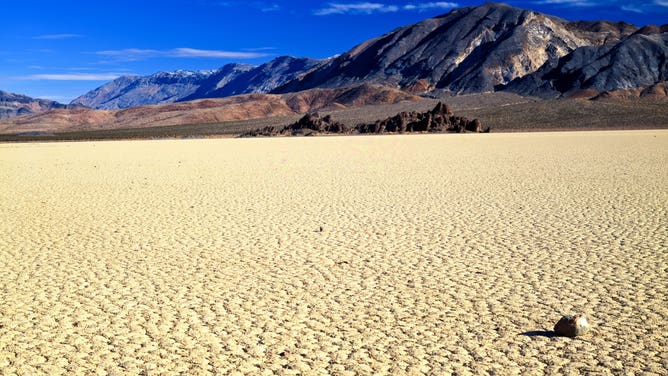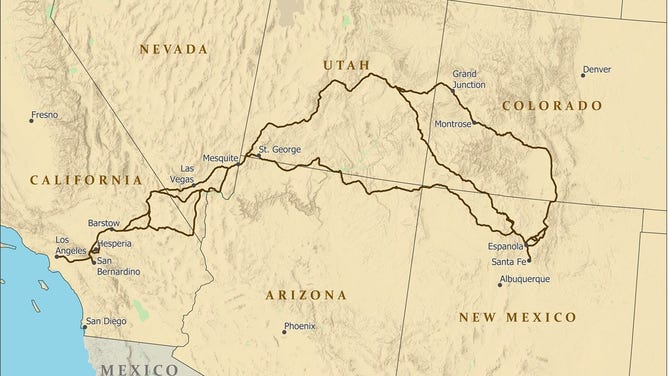Chilling irony: How world heat champ Death Valley owes name, in part, to a snowstorm
Learn about the incredible tale of survival that gave Death Valley its morbid moniker.

Nobody, California and Nevada, Death Valley National Park, The Racetrack and the Grandstand in the Cottonwood Mountains of the Panamint Range.
(Universal Images Group / Getty Images)
DEATH VALLEY, Calif. -- It's one of the planet's most imposing places -- a combination of extreme heat, complex terrain and a shortage of water sources. It's the only place on Earth to have been reliably measured to reach at least 130 degrees, and getting lost out there can quickly spell doom.
It even has an imposing name: Death Valley. But it's actually an incredible tale of survival that gave the valley its morbid moniker.
The name came amid the famous California Gold Rush in the mid-1800s that would later spawn "the 49ers." As word of the gold discovery at Sutter's Mill in 1848 spread across the nation, people from all over packed up their wagons and headed west in hopes of finding a better life.
One of the supply stops along the way was Salt Lake City, the final spot to load up before a daunting journey through the barren Nevada deserts and over the Sierra Nevada Mountains into the area just east of present-day Sacramento. By then, gold-seekers had learned not to attempt the mountain crossing in the winter because snowstorms in the Sierra Nevada would make travel too dangerous, as the Donner Party had infamously discovered a couple of years prior.
That was fresh on the minds of a large group of travelers -- 107 wagons in all -- who arrived in Salt Lake City in October of 1849, according to a historical account posted on the Death Valley National Park’s web page. It was already snow season in the Sierra, negating that route option and leaving them with the prospect of spending the winter in Salt Lake City.
But word spread of another potential option: The Old Spanish Trail. It was a route that headed south toward present-day Las Vegas and into southern California around the south end of the Sierra Nevada — a safer way to travel in the winter.

Map of Old Spanish Trail.
(U.S. National Park Service)
"The problems were that no pioneer wagon trains had traversed it, and they could only find one person in town who knew the route and would agree to lead them," according to the national park rangers.
A Perilous Choice
That man was Captain Jefferson Hunt, but it was a slow-go as Hunt would only lead as fast as the slowest wagon in the caravan. The slow pace was frustrating some of the other travelers, but fate presented a new option just before it came to a head.
"A young man rode into camp and showed some of the people a hand-sketched map that showed a fictitious 'short cut' across the desert to a place called Walker Pass," park rangers wrote. "Everyone agreed that this would cut off 500 miles from their journey, so most of the 107 wagons decided to follow this purported shortcut while the other wagons continued along the Old Spanish Trail with Captain Hunt."
The 'shortcut' immediately presented some problems -- a gaping canyon along what today is the Utah-Nevada state line. Most of the travelers who had defected became discouraged and went back to join Capt. Hunt, but 20 wagons decided to keep going.
They chose... poorly.
"It was a tedious chore getting the wagons around the canyon and took several days," NPS rangers wrote. "Despite the fact that the group didn't have a reliable map, they decided to continue on thinking that all they had to do was go west and they would eventually find (Walker Pass)."
‘Crazy looking’ cloud becomes key to survival
The group eventually made it through what is today Nevada, over summits and across barren valleys to Groom Lake. But then another fork in their plans: Part of the group wanted to head south toward a distant but snow-clad Mt. Charleston to search for water, as severe thirst now gripped the travelers from the trek through the arid landscape. The other group wanted to continue west.
The groups split up, yet both groups wound up heading toward what would become known as Death Valley.
Miles from any water source or civilization, their survival prospects were becoming grim until Mother Nature tossed them a literal lifeline: a snowstorm.
"During the night, a stray and crazy looking cloud passed over us and left its moisture on the mountain to the shape of a coat of snow several inches deep," one of the pioneers, Williams Lewis Manly, wrote in his autobiography in 1894. "When daylight came, the oxen crowded around the wagons, shivering with cold and licking up the snow to quench their thirst. We took pattern after them and melted snow to get water for ourselves."
Manly's group, who had headed south toward Mt. Charleston, eventually found their way to Travertine Springs -- the source of Furnace Creek -- on Christmas Eve. They had been traveling for two months now, and the oxen were weak from lack of food and water, and their wagons were in battered shape. Their one piece of luck was they were there at one of the few times to avoid extreme temperatures, as while the temperature can reach 120-plus degrees in the summer, they typically peak in the 60s in December and January.
The group that went west eventually had to slaughter their oxen and break up their wagons to use its wood for cooking the meat and making jerky, according to NPS. They continued on foot but eventually made their way over the Panamint Mountains and into the Indian Wells Valley, where they found a trail leading them to civilization in Southern California.

California and Nevada, Death Valley National Park, Dantes View in the Black Mountains provides a Panoramic view of Death Valleys Badwater Basin and the Panamint Range.
(Universal Images Group / Getty Images)
The Manly group tried to escape the valley over the Panamint Mountains via Warm Springs Canyon but failed and retreated to the valley floor.
The ‘Quick Trip’ that spanned weeks
There, the group sent Manly, who was 29 at the time, and another man ahead alone to find a route of escape. Assuming it was the Sierra Nevada Mountains, they thought it'd be a quick trip; instead, the men had to walk 300 miles over a month to reach a ranch at Mission San Fernando. There, they picked up supplies, three horses and a mule to return to their group.
But the three horses died along the return trek, leaving Manly to make it back to the group with just the lone mule.
When they arrived back in the valley, they found two families with children who had patiently waited the several weeks to be saved, while one man had died waiting and the others had set off on their own to find their route of escape.
Manly led the two families back west over the mountains out of the valley. And as they made their trek, they left an indelible mark on history.
"Just as we were ready to leave and return to camp, we took off our hats and then overlooking the scene of so much trial, suffering and death spoke the thought uppermost saying: -- 'Goodbye Death Valley!' then faced away and made our steps toward camp," Manly wrote. "Even after this in speaking of this long and narrow valley over which we had crossed into its nearly central part, and on the edge of which the lone camp was made, for so many days, it was called Death Valley. Many accounts have been given to the world as to the origin of the name and by whom it was thus designated, but ours were the first visible footsteps, and we the party which named it the saddest and most dreadful name that came to us first from its memories."
The hottest place on Earth had just received its deathly name from pioneers who didn't die, thanks to a winter storm.
Manly and the group would spend another 23 arduous days on their journey, having to cross the Mojave Desert before reaching Ranch San Francisco in the Santa Clarita Valley -- some four months after their ill-fated trek began. Manly would become a farmer and a writer, living mainly in California until his death at 83.